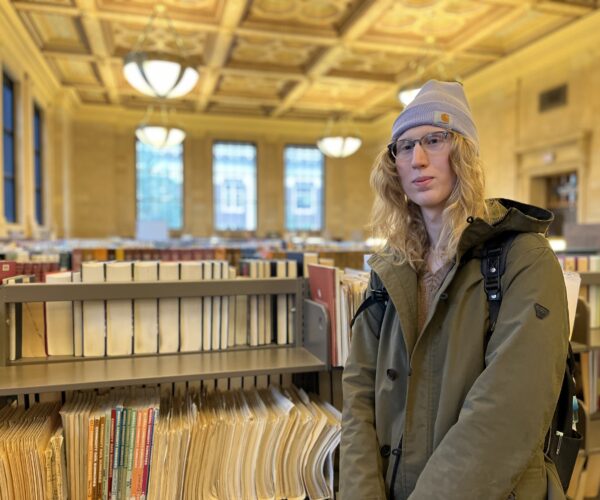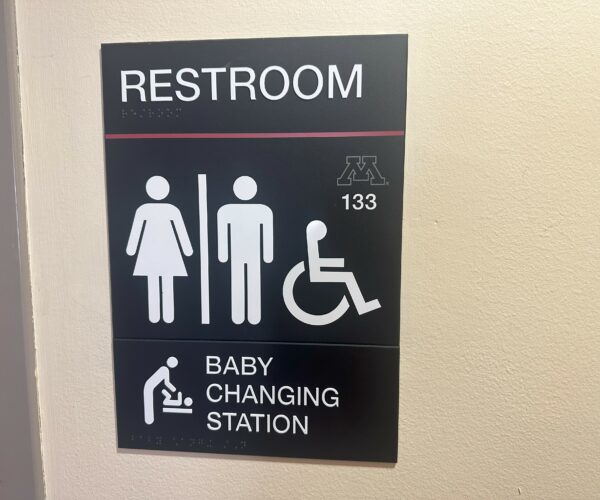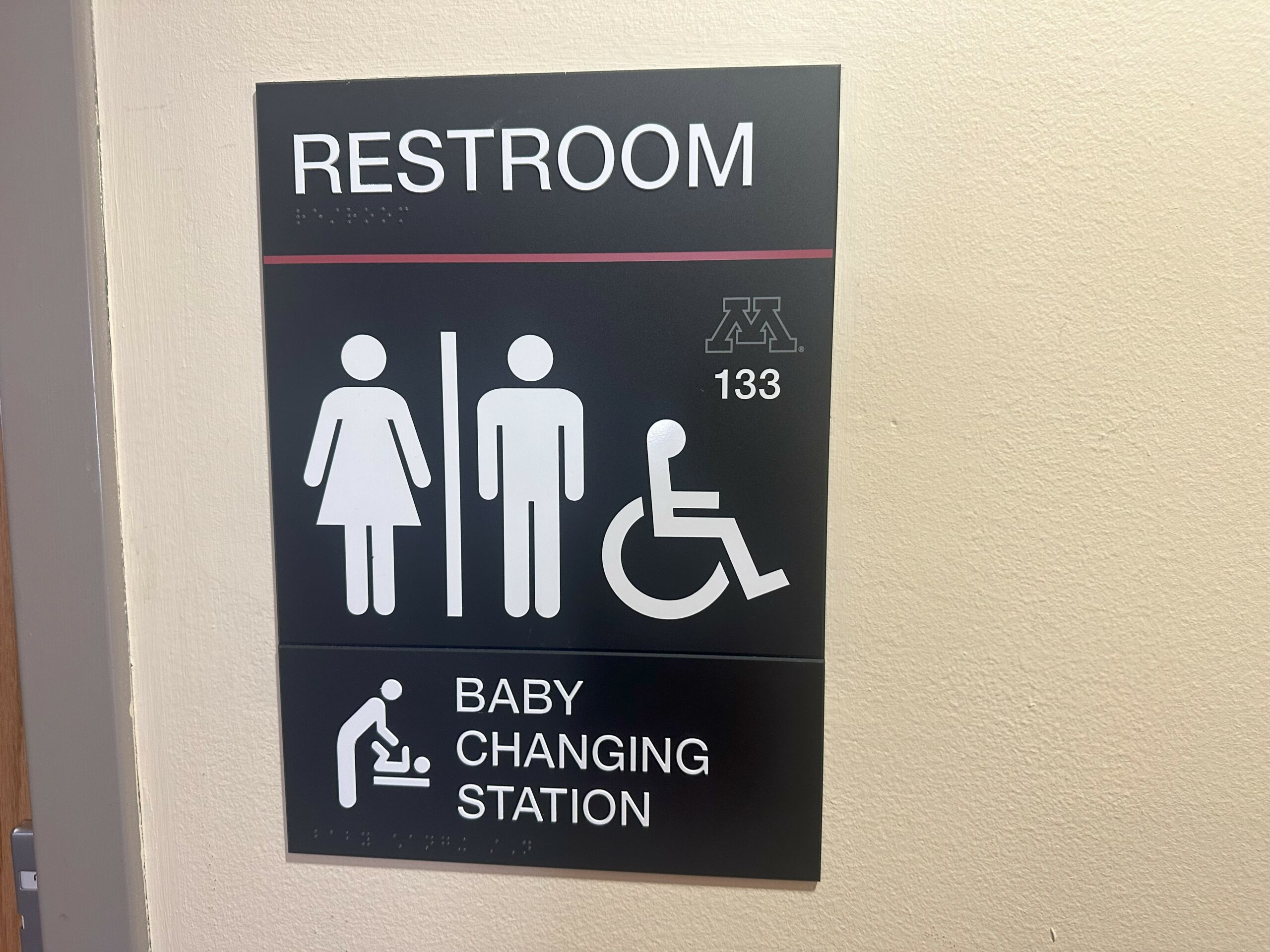By Abbey Machtig and Hanna Van Den Einde
University of Minnesota policy allows students 15 minutes to move between classes on the Twin Cities campus. But for those who need to use gender-neutral bathrooms, that travel time can get tricky.
An experiment conducted by AccessU: Queer on Campus tested this. It took slightly longer than 15 minutes to use the gender-neutral bathroom in Murphy Hall and walk across the Washington Avenue bridge to Blegen Hall, where there are no gender-neutral bathrooms. If conditions were just right — no snow, no line for the bathroom, no crowds on the mall or bridge — a student following this route would get to their class in the knick of time. If not, the student would be late.
While Minnesota does not have a law requiring gender-neutral restrooms in buildings, the University of Minnesota, as with many other colleges and universities, says it has made a commitment to installing these restrooms. Eight years ago, the University began a campus-wide effort to refit single-toilet bathrooms into all-gender facilities.
According to the Campus Pride Index, a national measure of LGBTQ+ campus inclusivity, the University of Minnesota scores well in providing access to gender-neutral bathrooms. It has five stars in the category that includes providing gender-inclusive or single-occupancy restroom facilities in campus housing. The index does not rate the quality of these facilities.
But some LGBTQ+ students who responded to an AccessU: Queer on Campus survey in March — some in anonymous comments in the survey and others in follow-up interviews — expressed frustration about campus’ gender-neutral restrooms. While many acknowledged the University’s effort to provide them, some students cited ongoing problems with accessibility and cleanliness of the facilities, particularly in residence halls.
The problems are not major, they say, but rather small inconveniences that add up. Some students also say gender inclusivity appears to be like an afterthought to University administrators.
One problem students pointed to was the University’s recent decision to lock bathrooms following incidents in which intruders entered dormitory bathrooms to watch students showering without their knowledge. While the policy was designed to keep students safe from such violations, the locks ended up restricting access for students to most gender-neutral bathrooms except the one on their dorm floor.
“The University's new bathroom lock policy — although good because it addresses the peeping Tom issue in other dorms — was not created with those who use non-gendered bathrooms in mind,” one survey respondent wrote.
The University effort
Gender-neutral bathrooms are located on all parts of the Twin Cities campus, according to the Gender and Sexuality Center. The University doesn’t require gender-neutral bathrooms in every building on campus, but including those spaces has become more of a priority for new construction or major renovations.
The University began its effort to create what it calls “all-gender bathrooms” in 2015. They began by repurposing existing male or female restrooms, David Hutton, the senior director of facilities management at the University, said in an email.
This project updated around 350 bathrooms on campus. Hutton said the goal of facilities management was to have several gender-neutral facilities available in each building, not to convert a specific percentage of bathrooms on campus. However, updates are sometimes limited by current plumbing and building configurations.
It’s difficult for the University to estimate exactly how much it has spent renovating gender-neutral bathrooms around campus because these changes are often included in projects where gendered bathrooms are also updated. One bathroom renovation project in the Sanford Hall dormitory cost around $7.4 million, according to a statement from University spokesperson Katie Ousley.
Hutton said his group worked with the University Trans Action and Advisory Team to determine signage on the restrooms and chose to refer to them as all-gender restrooms, rather than gender-neutral.
“We have also engaged with LGBTQ+ members of faculty, staff and student body, responding to questions and providing explanations around building code issues,” Hutton said.
The Education Advisory Board (EAB), a consulting firm specializing in education institutions, recommends buildings include directional signs indicating the nearest gender-neutral restroom to “ensure that students are able to find the closest one when they need it.”
EAB recommendations also include having gender-neutral bathrooms evenly spaced out on campus.
A campus decision
Different colleges and universities have taken their own approaches to gender-neutral bathroom access. At the University of California, Los Angeles, each bathroom location was assessed to ensure no gender-inclusive restroom was more than a two-minute walk away, according to EAB.
At the University of Minnesota, where bathrooms are scattered in some buildings but absent in others, students face practical challenges as they navigate their days. Traveling to another part of campus to find a restroom or enduring long wait times for a facility can cause delays for students who are making their way from class to class.
“I just keep getting flashbacks of my friends posting on their [social media] stories: ‘Wow, look at this is three flights up or, wow, this was like two blocks away from where I was,’” said Emily Nelson, a food science student at the University.
Emile Rauch, a queer and transmasculine student said many of their classes are located on West Bank. He described some areas of campus as “dead zones” for gender-neutral restrooms.
“There's that map that's very handy that I've saved so I know where they are in relation to my classes,” Rauch said. “There are some sections, mainly like the Blegen area, where you do have to go into a separate building to find a neutral bathroom.”
Korra Ringenberg, a University student and transgender woman, said she often struggles to find the bathrooms or the signage is unclear. Ringenberg said she often opts to use the women’s restroom when gender-neutral bathrooms aren’t available.
“I do just use the women's anyway because again I’m very far along in my transition. I don't feel uncomfortable with doing that,” Ringenberg said.
Some students report difficulty finding the bathrooms in the first place, as they may be located on a different floor, in an area that has controlled access or in a different building entirely.
When they do manage to find a bathroom, there’s no guarantee they’ll be able to access it if they’ve misplaced their UCard — a requirement to enter some bathrooms.
Dorm bathrooms
Survey respondents said University dormitories in particular had problems with gender-neutral bathrooms. Some shared concerns about cleanliness and even biohazards, while others reported long-term closures..
Housing and Residential Life (HRL) said all bathrooms — gendered and gender-neutral — are cleaned daily. Susan Stubblefield, interim director for HRL, said in an email statement she was not aware of any unusually extended bathroom closures.
Stubblefield did acknowledge one recurring biohazard issue in a campus dorm’s gender-neutral bathrooms.
“In one building, which has multiple gender-inclusive bathrooms, there have been repeated incidents of feces being found outside of the toilet,” Stubblefield said. “The situation has required professional cleaners to sanitize the space. Due to the multiple incidents, students may feel they have less access.”
While students raised concerns about the cleanliness and accessibility of gender neutral bathrooms on campus, some say the bigger issue is that there simply need to be more.
Claire Witzmann, a non-binary student at the University, said gender-neutral bathrooms are important and they would use the facilities — if more were available.
“I know that it’s because a lot of the buildings are outdated, but I don’t think it would be hard to just convert one bathroom into a gender-neutral bathroom, at least in every building on campus,” Witzmann said. “I think that’s the very least they could do. I don’t think that would be that difficult at all.”




